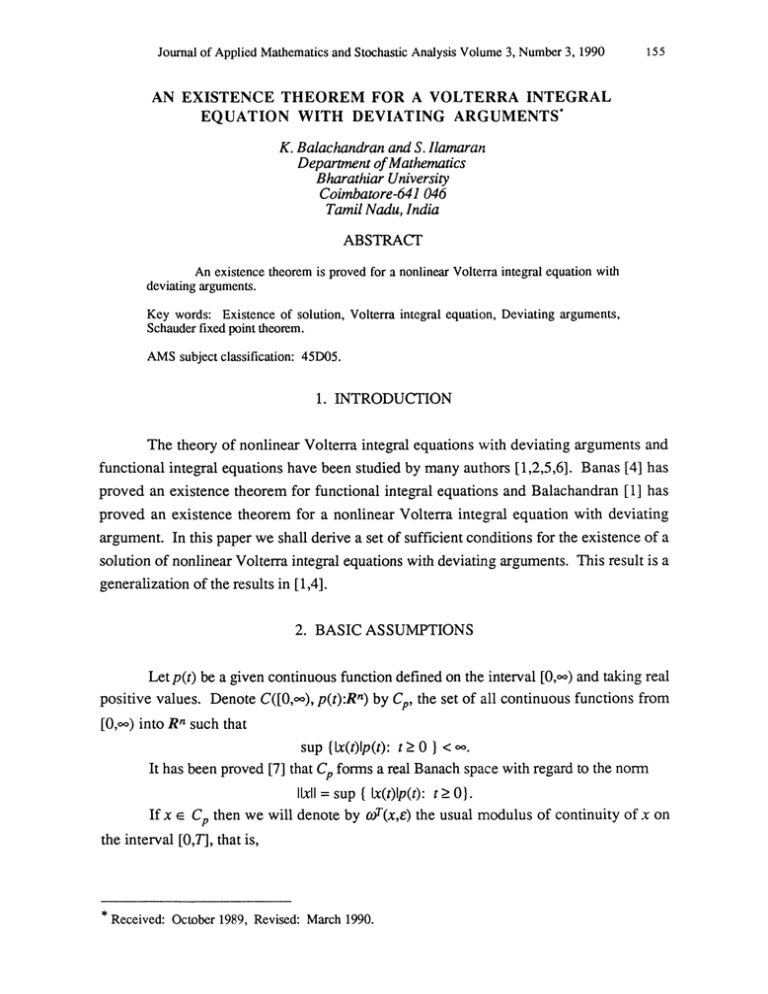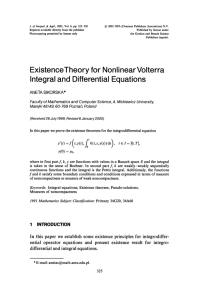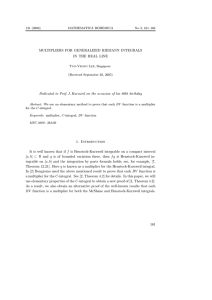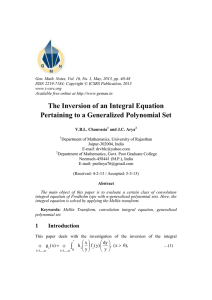ARGUMENTS" of
advertisement

Journal of Applied Mathematics and Stochastic Analysis Volume 3, Number 3, 1990
155
AN EXISTENCE THEOREM FOR A VOLTERRA INTEGRAL
EQUATION WITH DEVIATING ARGUMENTS"
K. Balachandran and S. Ilamaran
Department of Mathematics
Bharathiar University
Coimbatore-641 046
Tamil Nadu, India
ABSTRACT
An existence theorem is proved for a nonlinear Volterra integral equation with
deviating arguments.
Key words: Existence of solution, Volterra integral equation, Deviating arguments,
Schauder fixed point theorem.
AMS subject classification: 45D05.
1. INTRODUCTION
The theory of nonlinear Volterra integral equations with deviating arguments and
functional integral equations have been studied by many authors [ 1,2,5,6]. Banas [4] has
proved an existence theorem for functional integral equations and Balachandran 1] has
proved an existence theorem for a nonlinear Volterra integral equation with deviating
argument. In this paper we shall derive a set of sufficient conditions for the existence of a
solution of nonlinear Volterra integral equations with deviating arguments. This result is a
generalization of the results in [ 1,4].
2. BASIC ASSUMPTIONS
Let p(t) be a given continuous function defined on the interval [0,,,o) and taking real
positive values. Denote C([0,,,,,), p(t):R n) by Cp, the set of all continuous functions from
[0,,,,,) into R n such that
sup {Ix(t)lp(t): t>_ 0 < oo.
It has been proved [7] that Ct, forms a real Banach space with regard to the norm
Ilxll : sup Ix(t)lp(t): t >_ 0}.
If x Cp then we will denote by a)T(x,e) the usual modulus of continuity of x on
the interval [0,T], that is,
Received: October 1989, Revised: March 1990.
156
Journal of Applied Mathematics and Stochastic Analysis Volume 3, Number 3, 1990
Of(x,e) = sup {Ix(t)-x(s)l: It- si <_
,
t,s
[0,7"] }.
Our existence theorem is based on the following lemma.
Lemma (See [3].)" Let E be a bounded set in the space
belonging to E are equicontinuous on each interval [0,T] and
Cp. If all functions
lJrn {Ix(t)lp(t)" t >_ T} = 0
T--9
uniformly with respect to E, then E is relatively compact in Cp.
Consider the nonlinear Volterra integral equation with deviating arguments
(1) x(t) = G(x)g(t,x(h(t)), x(h(t)),...,x(hn(t))) +
JK(t,s,x(H(s)),...,x(nm(s)))ds
where x, H and K are n-vectors and G is a real-valued function. Assume the following
conditions.
(i) Let A = (t,s)" 0 _< s _< t < ,,}. The kernel K: A x R nm --+ R n is continuous and
there exist continuous functions m" A --+ [0,,), a" [0,,,,,)
(0,,,,,), and b: [0,,,,,) ---) [0,,,)
such that
m
IK(t,S,Xl,X2,...,xm)l < m(t,s) + a(t)b(s)
lxil
i=
for all (t,s)
zl and (Xl,Xz,...,Xm)
R m.
In order to formulate other assumptions let us define L(t) = a(s)b(s)ds,
t
> 0;
0
furthermore, let us take an arbitrary number M > 0 and consider the space Ce with
p(t) = [a(t)eML(t)+t] "1.
(ii) There exists a constant A > 0 such that for any t [0,) the following
inequality holds.
m(t,s)ds <_ Aa(t)eML(t)
o
[0,,) are continuous, hi(O) = O,
(iii) For = 1, 2,...,n the functions hi: [0,,,)
hi(t) <_ t for t >_ 0 and there exists a positive real number B such that a(hi(t)) <_ Bia(t).
(iv) G" Cp --+ [0,,,) is continuous and bounded. Assume IG(x)l _< kl where k is a
positive constant.
(v) The function g: [0,,) x Rnz --+ R is continuous and satisfies the conditions
n
Ig(t,Xl,X2,...,Xn) g(t,Yl,Y2,...,Yn)l <
Ci(t)lx
yi
i=1
where oi(t) is continuous such that
oti(t) <_ eMIL(t) "L(hi(t))] for t >_ 0, for = 1,2,...,n and Ig(t,0,...,0)l _< a(t)eML(t).
Existence Theorem for a Volterra Integral Equation: Balachandran and Ilamaran
(vi) For i = 1,2,...,m, the functions Hi: [0,,,,,)
the following conditions:
.
157
[0,,,,,) are continuous and satisfy
L(Hi(t) ) L(t) < N
where N is a positive constant, and
a(Hi(t))/a(t) <_ (M/m)[1- kl(1 + B)- A]e’MN
n
where B =
1=1
B i and we assume kl(1 + B) + A < 1.
3. EXISTENCE THEOREM
Theorem: Assume that the hypotheses (i) through (vi) hold; then equation (1) has
at least one solution x in the space Cp such that Ix(t)l < a(t)eML(O for any t >_ O.
Proof." Define a transformation F in the space by
(2)
(fx)(t) = G(x)g(t,x(h (t)), x(h(t)),...,x(hn(t)))
C
+
K(t,s,X(Hl(S)),...x(Hm(S)))ds.
From our assumptions we observe that (Fx)(t) is continuous on the interval [0,,). Define
the set E in Cp by
E = {x Cp: Ix(t)l _< a(t)eU’) }.
Clearly E is nonempty, bounded, convex, and closed in C,. Now we prove that F maps
the set E into itself. Take x e E. Then from our assumptions we have
I(Fx)(t)l <_ IG(x)l Ig(tX(hl (t)),...,x(hn(t)))l +
JlK(t,s,x(gl (s)),...,X(Hm(s)))lds.
< kllg(t,X(hl(t)),...,x(hn(t)))-g(t,0,...,0)l + kxig(t,O,...,O)l + m(t,s)ds
0
[b(s)
+ a(t)
alx(Hi(s))lds
o"
< k1
,ci(t)lx(hi(t))l + kla(t)eL(O + Aa(t)eML(t)
i= 1
+ a(t) b (s)/=
la(Hi(s))eML(H,<s))ds
0"
<_k
eM[C(0 "L(h(Ol]a(hi(t))eML(tti(t)) + ka(t)eMg(O + Aa(t)eMg(tl
i= 1
158
Journal of Applied Mathematics and Stochastic Analysis Volume 3, Number 3, 1990
+ a(t)([1- kl(l+ B)-A]/m)
eMNi[Mb(s)a(s)eMNi eML(s)dS
lBa(t)eML(t) + kla(t)eML(t) + Aa(t)eML(t) + a(t)[1 kl(1 + B) AleML(t)
= a(t)eML(t),
which proves that FE is a subset of E.
Now we want to prove that F is continuous on the set E. In order to do this we
take F = F + F2, where
(F1x)(t) = G(x)g(t,X(hl(t)),...,x(hn(t)) )
and
x,y
(F2x)(t) =
IK(t,s,x(H(s)),...,x(nm(s)))ds.
.
We shall prove the continuity of F and F2 separately. Let us fix e > 0 and take
E such that Ilx yll < We have
IIFlx Flyll <_ k sup{Ig(t,X(hl(t)),...,x(hn(t)))
g(t,y(hl(t)),...,y(hn(t)))l’[a(t)eML(t)+q’" t >_ 0}
+ IG(x)-G(y)lsup{Ig(t,y(h(t)),...,y(hn(t)))i.[a(t)eML(t)+t] -" t> 0}
<
k i=sup{ cti(t)lx(hi(t))- Y(hi(t))l[a(t)eML(t)+t] "1" t > 0}
+ IG(x) -G(y)l sup {Ig(t,y(h x(t)),...,y(hn(t)) ) -g(t,O,...,O)l.[a(t)eML(t)+q
+ IG(x) -G(y)l sup{Ig(t,O,...,O).[a(t)eML(t)+t] -1" t > 0}
"
t >_
O}
n
<- k ,Bisup{ Ix(hi(t)) Y(hi(t))l[a(hi(t))]-leM[L(t)-L(h(O)]e-ML(t)’t "t > 0}
i=
n
+lG(x) G(y)l
Z sup{tz/(t)ly(hi(t))l [a(t) eML(O +/]-1. t _> 0}
i=l
+ IG(x)- G(y)! sup { e -t" t >_ O}
<_ k
Bisup{Ix(hi(t))- y(hi(t))l[a(hi(t)) eML(hi(t)) + hi(t)]-I
t >_ O}
i=
n
+ IG(x)- G(y)l
sup{a(hi(t))eML(t)[a(t) etat t)+t]
t_> 0}+ IG(x)-G(y)l
i=l
<_ kI B II x-yll + B IG(x) G(y)l + IG(x) G(y)l.
This implies that F1 is continuous in view of (iv).
Now we prove that F2 is continuous on the set E. For this let us fix e > 0 and x, y
E such that I! x y II _< t;. Further, let us take an arbitrary fixed T > O. In view of (i)
and (vi) the function K(t, s, xI
xm) is uniformly continuous on
159
Existence Theorem for a Volterm Integral Equation: Balachandran and Ilamaran
[0, T] x[0, T]
x
[-r(HI(T)), r(H2(T))lx...x[-r(Hm(T)), r(Hm(T))]
where r(T) = max{a(s)eM(S s[O, T]. Thus, we have for t[0, T]
(3)
/(F2x) (t) (F2Y) (t) /
_<’f K(t,
0
s, x(HI(S)),..., x(nm(s))
-K(t, s, y (n(s)),..., Y(Hm(s)) / ds
lim
where fl(e)is some continuous function such that e-O
(e) =0.
Further, let us take
t _> T. Then we have
/ (F2x) (t)- (F2Y) (t) / _</(F2x) (t) / + / (F2Y) (t) /
<_ 2a (t)eML(t)
and
Hence for sufficiently large T we have
/ ( F2 x) (t)- (F2Y) (t)/p(t)
(4)
_
I (F2x) (t) (F2Y) (t)/ p(t) _<2e -t.
By (3) and (4) we get that F2 is continuous on the
set
E. Hence F = F1 + F2 is
continuous on E.
Now we prove that FE is relatively compact. For every x e E we have Fx E which
lim
>_ T } = 0
uniformly with
gives I(Fx)(t)lp(t) _< e "t Hence Tsup{l(Fx)(t)lp(t)’t
respect to xeE.
Furthermore, let us fix e >0 and T>O; and let t, se[O, T] such that lt-sl <_
x eE, we have
/ (Fx) (t)- (Fx)(s) / <_/G(x) / / g(t, X(hl(t)),..., x(hn(t)))
g(s, X(hl(S)),..., x(hn(s)) /
f
-f
+/
K(t, u, x(nl(tt)),..., x(Hm(u))du
0
K(s, u, y(H(u)),..., y(n(u))du /
0
.
Then for
160
_
Journal of Applied Mathematics and Stochastic Analysis Volume 3, Number 3, 1990
k o T (g, e)
+/fx(t,
u, X(Hl (U)),..., x(Hm(u)) du
o
f
K(t, u, x(H (u)),..., x(Hm(u))) du]
0
s
+/
_
f
K(t, u, x(H( )),..., x(Hm(u))) du
o
-f
K(s, u, x(HI(U)),..., x(Hm(u))) du /
0
k1 co
g, e) + f / K(t, u, x(HI(U)),..., x(Hm(u))) / du
s
_
$
+
f/K(t, u, x(HI(U)),..., x(Hm(u)))
0
-K(s,
,
x(H1 (u)),..., x(Hm(u))) / du
m
kI 09 T (g, e +
e max{ m(t, u) + a(t)b(u)
/ x(Hi(u) / o_u_t_<T}
i=l
+To T(K,e).
This tends to zero as e--0. Thus FE is equicontinuous on [0, T].
Therefore from the lemma FE is relatively compact. Thus the Schauder fixed point
theorem guarantees that F has a fixed point x E such that (Fx) (t) = x(t). Hence the
theorem holds.
EXAMPLE" Consider the following nonlinear integral equation:
(5)
x(t) = (1/8) tsinx (t/2) +
/[ts + (t + (1/4))x(s/3) 1
3
ds.
0
This is clearly of the form (1) and satisfies all the conditions (i) to (vi) with
Existence Theorem for a Volterm Integral Equation: Balachandran and Ilamaran
m = n = 1, G(x)
161
= 1/8, g(t, x) = t sinx,
K(t, s, x) = ts + (t3 + (1/4))x,
re(t, s) = ts, a(t) = t3 + (1/4), b(s) = 1,
a(t) = t, h(t) = t/2, H(t)= t/3,
M = 16, A = 1/2, B = 1, kI = 1/8,.N1 = 1/16.
_
Therefore from our existence theorem the equation (5) has at least one solution x in the
space Cp such that
4(t4 + t)
3
/ x(t) / (t + 1/4)e
for any t >_ O.
REFERENCES
[1]
Balachandran, K., Existence of Solution for Nonlinear Volterra Integral
Equation with Deviating Argument, J. Math. Phy. Sci., 23(1989), 201205.
[2]
Banas, J., An Existence Theorem for Nonlinear Volterra Integral Equation
with Deviating Argument, Rendiconti del Circolo Mathematico di Palermo,
Series 2, 35(1986), 82-89.
[31
Banas. J. and Goebel, K., Measure of Noncompactness in Banach Spaces,
Marcel Dekkar Inc., New York (1980).
[4]
Banas, J., On Solutions of Some Functional Integral Equations, Bull. Inst.
Math. Acad. Sinica, 12(1984), 23-30.
162
Journal of Applied Mathematics and Stochastic Analysis Volume 3, Number 3, 1990
[5]
Brauer, F.,.A Nonlinear Variation of Constant Formula for Volterra
Equations, Math. Systems Theory, 6 (1972), 226-234.
[61
Burton, T.A., Volterra Integral and Differential Equations, Academic Press,
New York, (1983).
[7]
Corduneanu, C., Integral Equations and Stability of Feedback Systems,
Academic Press, New York (1973).
[8]
Kartsatos, A.G., Existence of Bounded Solutions and Asymptotic
Relationships for Nonlinear Volterra Integral Equations, Math. Systems
Theory 8, (197 4), 266-27 5.
[9]
Lakshmikanthem, V. and Leela, S., Differential and Integral Inequalities,
Vol. I, Academic Press, New York (1969).





